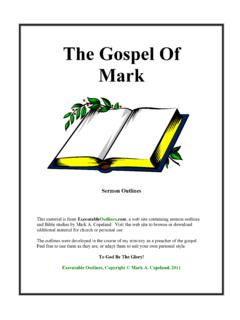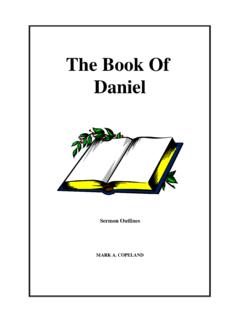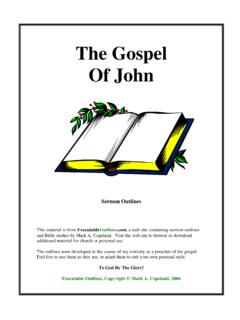Transcription of comprehension bookmarks - Mrs. Bainbridge's Class Website
1 comprehension bookmarks Print these for your students. I have included two copies one you can print in color and laminate for your students, and one in black and In my classroom, I plan to print the color bookmarks on cardstock, laminate, cut, and add a tassel to the top. Run copies back to back and cut down the middle. The circle at the top is so you can add a tassel or ribbon for your students. Christina Bainbridge graphics Thistle Girl Designs Good Readers use many skills & strategies to help them understand & remember the text they're reading. Good Readers use many skills & strategies to help them understand & remember the text they're reading.
2 Cause & Effect Good readers understand how things happen by looking at the cause. Good readers understand what happens by thinking about the effect. Cause & Effect Good readers understand how things happen by looking at the cause. Good readers understand what happens by thinking about the effect. Compare & Contrast Good readers think about how characters, settings, and events in a text are alike and different. Compare & Contrast Good readers think about how characters, settings, and events in a text are alike and different. Finding What's Important Good readers can find what's important in a text.
3 They ask: What is the main idea that the author is trying to tell you? What are the details that support the main idea? Finding What's Important Good readers can find what's important in a text. They ask: What is the main idea that the author is trying to tell you? What are the details that support the main idea? Inferring Good readers use what they already know plus what they read to make logical decisions about what an author means in a text. Inferring Good readers use what they already know plus what they read to make logical decisions about what an author means in a text.
4 Making Connections Good readers make connections to themselves, other texts, and the world to help themselves understand what they're reading. Making Connections Good readers make connections to themselves, other texts, and the world to help themselves understand what they're reading. Questioning Good readers ask questions before, during, and after reading! Questioning Good readers ask questions before, during, and after reading! Predicting Good readers think about what might happen before and during a text they read. Good readers check their predictions while they read. Predicting Good readers think about what might happen before and during a text they read.
5 Good readers check their predictions while they read. Repairing Good readers have strategies to use when a text doesn t make sense: **Re read the sentence** **Look at the pictures** **Mark the page and ask for help** Repairing Good readers have strategies to use when a text doesn t make sense: **Re read the sentence** **Look at the pictures** **Mark the page and ask for help** Story Elements Good readers can identify story elements: **Setting** **Characters ** **Beginning/Middle/End** **Problem/Solution** Story Elements Good readers can identify story elements: **Setting** **Characters** **Beginning/Middle/End** **Problem/Solution** Summarizing Good readers can retell about the text they've read.
6 You can retell by following: "Somebody wanted but so." Summarizing Good readers can retell about the text they've read. You can retell by following: "Somebody wanted but so." Visualizing Good readers get pictures of what they're reading in their minds. Good readers make sure their pictures make sense with what they're reading. Visualizing Good readers get pictures of what they're reading in their minds. Good readers make sure their pictures make sense with what they're reading. Good Readers use many skills & strategies to help them understand & remember the text they're reading.
7 Good Readers use many skills & strategies to help them understand & remember the text they're reading. Cause & Effect Good readers understand how things happen by looking at the cause. Good readers understand what happens by thinking about the effect. Cause & Effect Good readers understand how things happen by looking at the cause. Good readers understand what happens by thinking about the effect. Compare & Contrast Good readers think about how characters, settings, & events in a text are alike & different. Compare & Contrast Good readers think about how characters, settings, & events in a text are alike & different.
8 Finding What's Important Good readers can find what's important in a text. They ask: What is the main idea that the author is trying to tell you? What are the details that support the main idea? Finding What's Important Good readers can find what's important in a text. They ask: What is the main idea that the author is trying to tell you? What are the details that support the main idea? Inferring Good readers use what they already know plus what they read to make logical decisions about what an author means in a text. Inferring Good readers use what they already know plus what they read to make logical decisions about what an author means in a text.
9 Making Connections Good readers make connections to themselves, other texts, and the world to help themselves understand what they're reading. Making Connections Good readers make connections to themselves, other texts, and the world to help themselves understand what they're reading. Questioning Good readers ask questions before, during, and after reading! Questioning Good readers ask questions before, during, and after reading! Predicting Good readers think about what might happen before and during a text they read. Good readers check their predictions while they read. Predicting Good readers think about what might happen before and during a text they read.
10 Good readers check their predictions while they read. Repairing Good readers have strategies to use when a text doesn t make sense: **Re read the sentence** **Look at the pictures** **Mark the page and ask for help** Repairing Good readers have strategies to use when a text doesn t make sense: **Re read the sentence** **Look at the pictures** **Mark the page and ask for help** Story Elements Good readers can identify story elements: **Setting** **Characters ** **Beginning/Middle/End** **Problem/Solution** Story Elements Good readers can identify story elements: **Setting** **Characters ** **Beginning/Middle/End** **Problem/Solution** Summarizing Good readers can retell about the text they've read.












